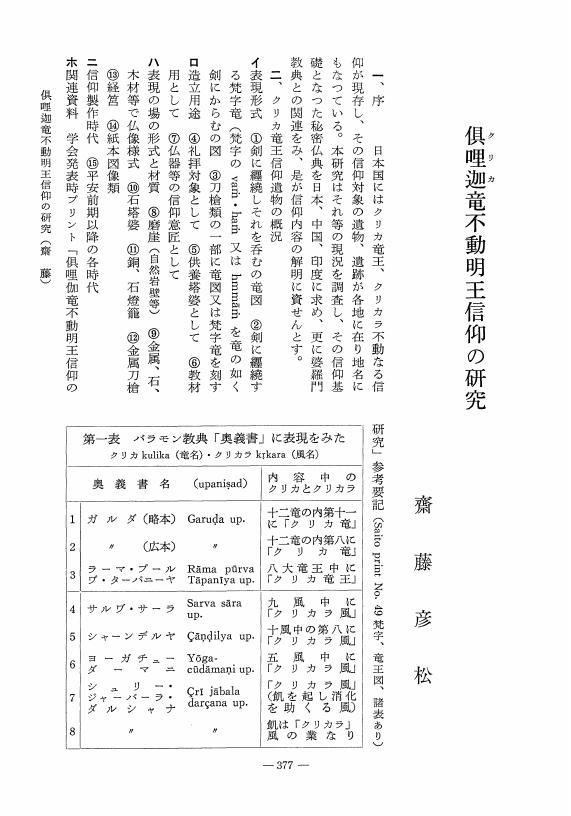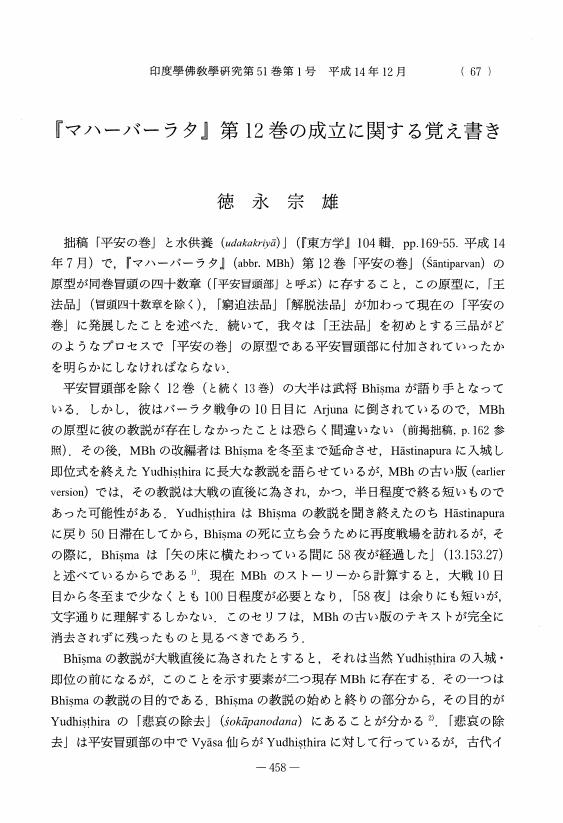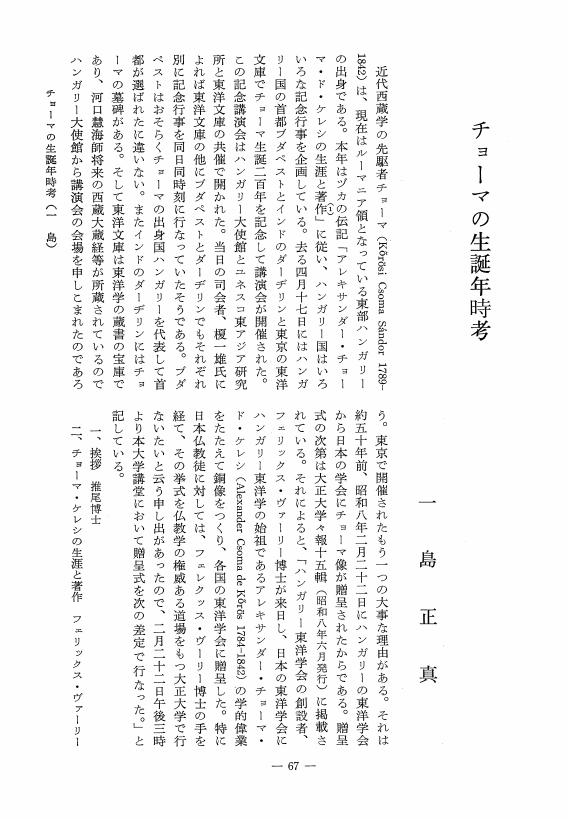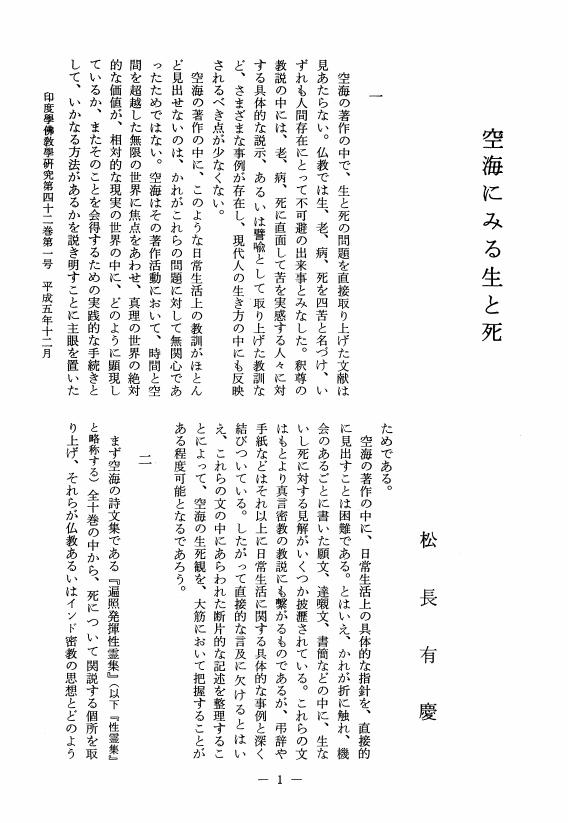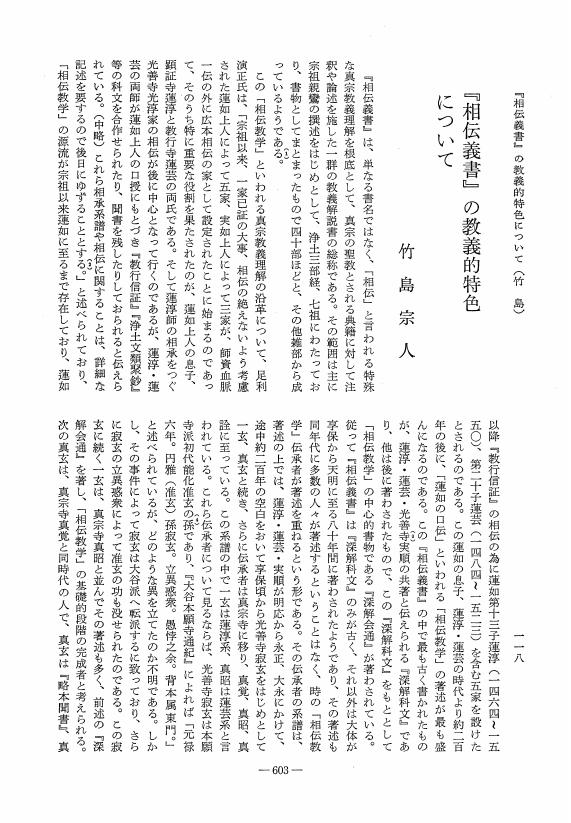3 0 0 0 OA インドの祖霊崇拝/ブータをめぐって
- 著者
- 河野 亮仙
- 出版者
- Japanese Association of Indian and Buddhist Studies
- 雑誌
- 印度學佛教學研究 (ISSN:00194344)
- 巻号頁・発行日
- vol.37, no.2, pp.976-974, 1989-03-20 (Released:2010-03-09)
- 参考文献数
- 11
3 0 0 0 OA クリシュナムルティの自然観
- 著者
- 西尾 秀生
- 出版者
- Japanese Association of Indian and Buddhist Studies
- 雑誌
- 印度學佛教學研究 (ISSN:00194344)
- 巻号頁・発行日
- vol.47, no.1, pp.488-484, 1998-12-20 (Released:2010-03-09)
3 0 0 0 OA 大樹寺の成立過程について -大樹寺と松平親忠-
- 著者
- 佐々木 洋之
- 出版者
- Japanese Association of Indian and Buddhist Studies
- 雑誌
- 印度學佛教學研究 (ISSN:00194344)
- 巻号頁・発行日
- vol.18, no.1, pp.331-333, 1969-12-25 (Released:2010-03-09)
3 0 0 0 OA 倶哩迦竜不動明王信仰の研究
- 著者
- 齋藤 彦松
- 出版者
- JAPANESE ASSOCIATION OF INDIAN AND BUDDHIST STUDIES
- 雑誌
- 印度學佛教學研究 (ISSN:00194344)
- 巻号頁・発行日
- vol.27, no.1, pp.377-380, 1978-12-31 (Released:2010-03-09)
3 0 0 0 OA 『マハーバーラタ』第12巻の成立に関する覚え書き
- 著者
- 徳永 宗雄
- 出版者
- Japanese Association of Indian and Buddhist Studies
- 雑誌
- 印度學佛教學研究 (ISSN:00194344)
- 巻号頁・発行日
- vol.51, no.1, pp.458-456, 2002-12-20 (Released:2010-03-09)
3 0 0 0 OA チョーマの生誕年時考
- 著者
- 一島 正真
- 出版者
- Japanese Association of Indian and Buddhist Studies
- 雑誌
- 印度學佛教學研究 (ISSN:00194344)
- 巻号頁・発行日
- vol.33, no.1, pp.67-71, 1984-12-25 (Released:2010-03-09)
3 0 0 0 OA 空海にみる生と死
- 著者
- 松長 有慶
- 出版者
- Japanese Association of Indian and Buddhist Studies
- 雑誌
- 印度學佛教學研究 (ISSN:00194344)
- 巻号頁・発行日
- vol.42, no.1, pp.1-11, 1993-12-25 (Released:2010-03-09)
- 被引用文献数
- 1
3 0 0 0 OA 『相伝義書』の教義的特色について
- 著者
- 竹島 宗人
- 出版者
- Japanese Association of Indian and Buddhist Studies
- 雑誌
- 印度學佛教學研究 (ISSN:00194344)
- 巻号頁・発行日
- vol.31, no.2, pp.603-604, 1983-03-25 (Released:2010-03-09)
3 0 0 0 OA スリランカにおける菩薩王の理想とサンガ改革
- 著者
- 藪内 聡子
- 出版者
- Japanese Association of Indian and Buddhist Studies
- 雑誌
- 印度學佛教學研究 (ISSN:00194344)
- 巻号頁・発行日
- vol.55, no.3, pp.1136-1139, 2007-03-25 (Released:2010-03-09)
- 参考文献数
- 4
ポロンナルワ時代, スリランカ史上最大の英雄と称される Parakkamabahu I 世 (1153-1186 A. D.) は, それまで Mahavihara, Abhayagiri, Jetavana の三派に分かれていたスリランカのサンガに対して, Mahavihara 派の受戒のみを承認してサンガの統一を断行したが, それが可能であったのは, アヌラーダプラ時代に遡り, 政治的概念として菩薩王思想が受容されて浸透したからであることが, 史書や碑文資料により認められる.菩薩王思想は, アヌラーダプラ時代初期については Abhayagiri 派と関連して発展したが, アヌラーダプラ時代中期以降は派とは関係なく独自に進展を遂げ, 政治的イデオロギーとして, 王の存在を限りなく仏陀に近い存在にし, 王権の正当性を強化して, サンガに対する行使力増大に寄与した. ポロンナルワ時代には, 南インドからの侵略のために, ことに王は軍事的頂点の存在として英雄性が重視されるが, 菩薩王思想は英雄性と混在し, サンガ統一により Mahavihara 派のみが存在するようになった後も, イデオロギー化して Mahavihara 派と同化して存続することになる.
3 0 0 0 OA 柘植信秀の真宗論
- 著者
- 山崎 龍明
- 出版者
- Japanese Association of Indian and Buddhist Studies
- 雑誌
- 印度學佛教學研究 (ISSN:00194344)
- 巻号頁・発行日
- vol.51, no.2, pp.682-687, 2003-03-20 (Released:2010-03-09)
3 0 0 0 OA 長水子〓の無情成仏説
- 著者
- 吉田 剛
- 出版者
- Japanese Association of Indian and Buddhist Studies
- 雑誌
- 印度學佛教學研究 (ISSN:00194344)
- 巻号頁・発行日
- vol.51, no.1, pp.56-60, 2002-12-20 (Released:2010-03-09)
3 0 0 0 OA 摂津中嶋三宝寺とその周辺
- 著者
- 西岡 秀爾
- 出版者
- Japanese Association of Indian and Buddhist Studies
- 雑誌
- 印度學佛教學研究 (ISSN:00194344)
- 巻号頁・発行日
- vol.55, no.2, pp.1007-1004,1288, 2007-03-20 (Released:2010-07-01)
Sanboji in Settsu Nakajima is a temple built by Nonin in order to spread the Dharma sect. This article traces the origin of the temple by referring to literature of the Middle Ages and old maps.Recently, the origin of the Sanboji temple has been traced to Daido-the second and third wards of the neighborhood of the Osaka University of Economics in Daido district. However, topography and medieval documents connected with the Sozenji, Monoi family, and so on, suggest that the origin of the temple is not restricted to Daido, but extends to the wider-ranging area of Komatsu Zuiko and Osumi district, spanning the whole territory. Although the time of existence of the temple is still unknown, it is believed to have existed until the third year of Onin (1469), based on the “摂州中嶋三宝寺六祖舎利大慧袈裟伝来記” of the Shoboji historical records. Furthermore, its existence during the time of Daiei (1521-1526) or Kyoroku (1528-1531) is questioned. Even though the temple disappeared, the Komatsu and Nishidaido districts located to the north from the origin of Sanboji were called Sanboji, and remained so until the first half of the 20th century.
3 0 0 0 OA 愚管抄における叡山仏教
- 著者
- 渡辺 守順
- 出版者
- JAPANESE ASSOCIATION OF INDIAN AND BUDDHIST STUDIES
- 雑誌
- 印度學佛教學研究 (ISSN:00194344)
- 巻号頁・発行日
- vol.26, no.2, pp.753-756, 1978-03-20 (Released:2010-03-09)
- 参考文献数
- 8
3 0 0 0 OA 古典劇「土の小車」の著者シュードラカについて
- 著者
- 岩本 裕
- 出版者
- JAPANESE ASSOCIATION OF INDIAN AND BUDDHIST STUDIES
- 雑誌
- 印度學佛教學研究 (ISSN:00194344)
- 巻号頁・発行日
- vol.3, no.2, pp.448-451, 1955-03-30 (Released:2010-03-09)
3 0 0 0 シャンバラ国について
- 著者
- 西岡 祖秀
- 出版者
- JAPANESE ASSOCIATION OF INDIAN AND BUDDHIST STUDIES
- 雑誌
- 印度學佛教學研究 (ISSN:00194344)
- 巻号頁・発行日
- vol.55, no.1, pp.474-468,1230, 2006
The Country of Shambhala is an ideal Buddhist kingdom described in the <i>Kalacatantra</i>. The 25<sup>th</sup> generation Raudracakrin king of this country is said to win the final war with Islam, and revive Buddhism. When the <i>Kalacakratantra</i> was introduced to Tibet after the 11th century, it was widely accepted by Tibetan Buddhists. 'Jam-dbyangs-bzhad-pa (1648-1722) and Sumpa-mkhan-po (1704-1788), who were great scholars of the dGe lugs sect in the 18th century, wrote Chronological Tables of Tibetan Buddhism. The enthronement of the king of Shambhala is stated in both chronological tables, and the revival of Buddhism by the Raudracakrin king is predicted. This paper provides a general description of the Country of Shambhala from the <i>Dang po'i rgyas dpal dus kyi 'khor lo'i lo rgyus dang ming gi rnam grangs</i> of Klong-rdol-bla-ma (1719-1805), who was a great scholar of the dGe lugs sect.
3 0 0 0 OA 後期グプタ朝の分裂について
- 著者
- 山田 明爾
- 出版者
- JAPANESE ASSOCIATION OF INDIAN AND BUDDHIST STUDIES
- 雑誌
- 印度學佛教學研究 (ISSN:00194344)
- 巻号頁・発行日
- vol.12, no.2, pp.620-627, 1964-03-31 (Released:2010-03-09)
3 0 0 0 OA 『正法華経』薬王如来品と『維摩経』法供養品について
- 著者
- 河野 訓
- 出版者
- JAPANESE ASSOCIATION OF INDIAN AND BUDDHIST STUDIES
- 雑誌
- 印度學佛教學研究 (ISSN:00194344)
- 巻号頁・発行日
- vol.46, no.1, pp.242-246, 1997-12-20 (Released:2010-03-09)
3 0 0 0 OA 悪人正機説の系譜について
- 著者
- 梶村 昇
- 出版者
- JAPANESE ASSOCIATION OF INDIAN AND BUDDHIST STUDIES
- 雑誌
- 印度學佛教學研究 (ISSN:00194344)
- 巻号頁・発行日
- vol.19, no.1, pp.348-353, 1970-12-25 (Released:2010-03-09)
3 0 0 0 世親淨土論に於ける十地經的要素
- 著者
- 長谷岡 一也
- 出版者
- JAPANESE ASSOCIATION OF INDIAN AND BUDDHIST STUDIES
- 雑誌
- 印度學佛教學研究 (ISSN:00194344)
- 巻号頁・発行日
- vol.6, no.2, pp.493-496, 1958
3 0 0 0 OA 佛教心理學の成立と課題
- 著者
- 西光 義敞
- 出版者
- JAPANESE ASSOCIATION OF INDIAN AND BUDDHIST STUDIES
- 雑誌
- 印度學佛教學研究 (ISSN:00194344)
- 巻号頁・発行日
- vol.6, no.2, pp.461-464, 1958-03-30 (Released:2010-03-09)



